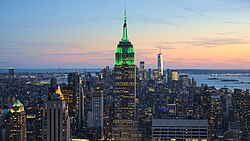 New York City, the economic capital of New York (state) and the world | |
| Statistics | |
|---|---|
| GDP | $2.322 trillion (2024) [1] |
GDP per capita | $116,883 (2024) [2] |
Population below poverty line | 13.6% [3] |
| 0.5157 ± 0.0029 (2023) [4] | |
Labour force | 9,645,984 (2023) [5] |
| Unemployment | 4.0% (Aug. 2025) [6] |
| Public finances | |
| Revenues | $63.5 billion [7] |
| Expenses | $54.6 billion [8] |
The economy of the State of New York is reflected in its gross state product in 2024 of $2.322 trillion, ranking third in size behind the larger states of California and Texas. If New York State were an independent nation, it would rank as the 8th largest economy in the world by nominal GDP. However, in 2024, the multi-state, New York City-centered metropolitan statistical area produced a gross metropolitan product (GMP) over $US2.6 trillion, ranking first nationally by a wide margin and also ranked as the largest GDP in the world. By 2025, tourism had become New York's second-largest industry, after finance. [9]
Contents
- New York City
- Long Island
- Agriculture
- Energy
- Solar power
- Wind power
- Largest Fortune 500 companies in New York (2022)
- See also
- References


The state has a large manufacturing sector, which includes printing and publishing and the production of computers, consumer electronics, apparel, railroad rolling stock, and bus line vehicles. Some industries are concentrated in upstate locations also, such as ceramics and glass (the southern tier of counties), microchips and nanotechnology (Albany) and the Greater Capital District, and photographic equipment (Rochester). New York's agricultural outputs comprise dairy products, cattle and other livestock, vegetables, nursery stock, and apples. In April 2021, GlobalFoundries, a company specializing in the semiconductor industry, moved its headquarters from Silicon Valley, California to its most advanced semiconductor-chip manufacturing facility in Saratoga County near a section of the Adirondack Northway, in Malta, New York. [10]



